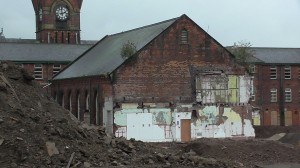Carran’s Working Diary 7: Lines, Tributaries and Transformations
Back to the Working House after the diagonal journey from North West to South East.
I am back in the Working House for one day to reflect on and improvise around a recent journey to East Anglia and Essex passing through Gressenhall Workhouse, Norfolk, Lexden and Winstree Union Workhouse, Stanway, Essex (latterly St Albtight’s Hospital); Poor Houses in Peldon, Essex and Samford Union Workhouse, Tattingstone (latterly St Mary’s Hospital).
I am swimming in the streams of two water systems on the diagonal of England that is North West to South East: (Mersey and Mersea), observing three tributaries: Old Poor Law, New Poor Law and Public Assistance flowing into a river of national care North and South between 1800 and 1948.
The ebb and flow of these tributaries allows personal story to ripple on stark lines imprinted on huge ledgers that form the columns for the documentation of those who made use of this care in its many forms. These lines of documentation rise up like the tall walls that separate male from female, able bodied from infirm, rich from poor, legitimate from illegitimate. Imagination kicks up a storm threatening to flush out hidden depths of memory that lie silent and unspoken etched on the layers of wallpaper, paint, plaster and brickwork now tidily patched up in the 21st century residential complexes sporting euphemistic titles that hide and declare these institutions’ former existences: Samford Court, Chedworth Place, St Albright’s Place for example.
This is a documentation system that my Nana-in-Hospital and my Mum experienced in its guise as public assistance in the 1930s; that Great Grandfather and Great, Great Grandmother Harvey experienced in its guise as the New Poor Law in the 1860s and that Great, Great, Great Grandparents Joseph and Elizabeth Harvey experienced in the guise of the Old Poor Law 200 years ago.
I have found the fragments of a trio of family stories that have as their kernels the shadowy care of a system struggling to know, amongst other concerns, what to do about fatherless children whilst at the same time making the books balance. I am considering what makes society shut in in an old system and turn away in a new one, when considering also our present systems of care.
And I have also thought – so what is the point of all of this? Why try to pull all this together in a piece of performance? I am still working that one out but I have found that by trusting the “what if?, allowing my imagination to coast and being in that moment when the historical document confirms the “what if?” I discover a root network I did not have before and through that personal discovery I find I begin to see the point: those real people and the evidence of their existence in little fragments on fading pages in large ledgers makes them part of a story that is bigger than a performance. It may resonate with contemporary parallels on levels and layers I am yet to explore.
Focussing on Dearnley Workhouse, what is now Birch Hill Hospital in Rochdale, gives me a context that is more meaningful now because of my recent journey on a diagonal line across time and space. Through the identification of my own family’s names in huge ledgers in the south and south east of England, I can be an associate of those numerous people contained in the huge ledgers, brickwork and crumbling reincarnations overtaking the site at Birch Hill as it transforms into yet another residential complex with a for sale sign over its head.



Comments are closed
Sorry, but you cannot leave a comment for this post.